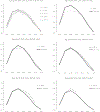Reconstruction of Birth Histories for the Study of Fertility in the United States, 1830-1910
- PMID: 34853487
- PMCID: PMC8631723
- DOI: 10.1080/01615440.2019.1664357
Reconstruction of Birth Histories for the Study of Fertility in the United States, 1830-1910
Abstract
This paper describes a method to reconstruct complete birth histories for women in the 1900 and 1910 U. S. census IPUMS samples. The method is an extension of an earlier method developed by Luther and Cho (1988). The basic method relies on the number of children ever born, number of children surviving, number of children coresident in the household and age-specific fertility rates for the population to probabilistically assign an "age" to deceased and unmatched children. Modifications include the addition of an iterative Poisson regression model to fine-tune age-specific fertility inputs. The potential of complete birth histories for the study of the U.S. fertility transition is illustrated with a few examples.
Figures








References
-
- Alter G. 2016. Understanding historical and contemporary fertility transitions: A birth interval approach. Paper presented at the seminar “Linking past to present: Long-term perspectives on micro-level demographic processes,: organized by the IUSSP Scientific Panel on Historical Demography, Reitaku University, Kashiwa, Japan, December 9–11.
-
- Alter G. and Hacker JD 2019. The impact of multiple births on fertility and family support in the early 20th-century. Paper presented at the IUSSP International Seminar on Kinship and Reproduction in Past Societies, Minneapolis, Minnesota, August 23, 2019.
-
- Anderton DL and Bean LL 1985. Birth spacing and fertility limitation: A behavioral analysis of a 19th-century frontier population. Demography 22: 169–183. - PubMed
-
- Bengtsson T. and Dribe M. 2006. Deliberate control in a natural fertility population: Southern Sweden, 1766–1864. Demography 43: 727–746. - PubMed
-
- Brass W. 1960. The graduation of fertility distributions by polynomial functions. Population Studies 14: 148–162.
Grants and funding
LinkOut - more resources
Full Text Sources
